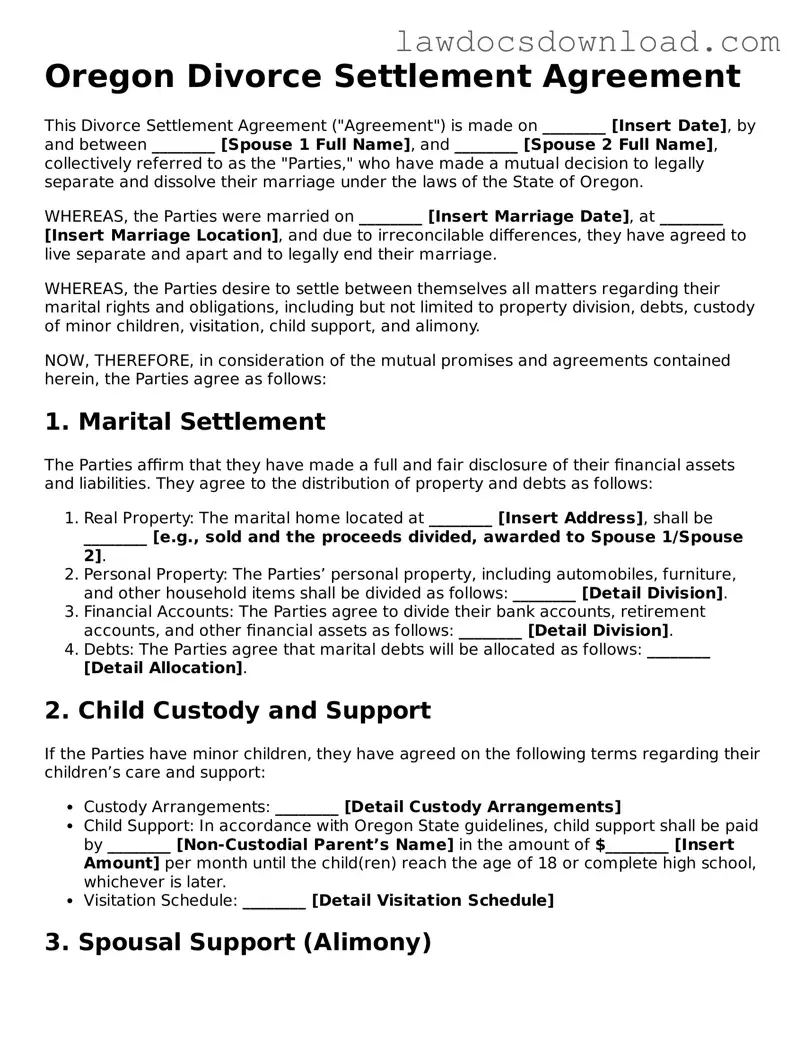Oregon Divorce Settlement Agreement
This Divorce Settlement Agreement ("Agreement") is made on ________ [Insert Date], by and between ________ [Spouse 1 Full Name], and ________ [Spouse 2 Full Name], collectively referred to as the "Parties," who have made a mutual decision to legally separate and dissolve their marriage under the laws of the State of Oregon.
WHEREAS, the Parties were married on ________ [Insert Marriage Date], at ________ [Insert Marriage Location], and due to irreconcilable differences, they have agreed to live separate and apart and to legally end their marriage.
WHEREAS, the Parties desire to settle between themselves all matters regarding their marital rights and obligations, including but not limited to property division, debts, custody of minor children, visitation, child support, and alimony.
NOW, THEREFORE, in consideration of the mutual promises and agreements contained herein, the Parties agree as follows:
1. Marital Settlement
The Parties affirm that they have made a full and fair disclosure of their financial assets and liabilities. They agree to the distribution of property and debts as follows:
- Real Property: The marital home located at ________ [Insert Address], shall be ________ [e.g., sold and the proceeds divided, awarded to Spouse 1/Spouse 2].
- Personal Property: The Parties’ personal property, including automobiles, furniture, and other household items shall be divided as follows: ________ [Detail Division].
- Financial Accounts: The Parties agree to divide their bank accounts, retirement accounts, and other financial assets as follows: ________ [Detail Division].
- Debts: The Parties agree that marital debts will be allocated as follows: ________ [Detail Allocation].
2. Child Custody and Support
If the Parties have minor children, they have agreed on the following terms regarding their children’s care and support:
- Custody Arrangements: ________ [Detail Custody Arrangements]
- Child Support: In accordance with Oregon State guidelines, child support shall be paid by ________ [Non-Custodial Parent’s Name] in the amount of $________ [Insert Amount] per month until the child(ren) reach the age of 18 or complete high school, whichever is later.
- Visitation Schedule: ________ [Detail Visitation Schedule]
3. Spousal Support (Alimony)
The Parties ________ [choose one: agree/do not agree] to alimony terms. If agreed, ________ [Spouse 1/Spouse 2] shall pay to ________ [Spouse 1/Spouse 2], the sum of $________ [Insert Amount] per month for a period of ________ [Insert Period].
4. Entire Agreement
This Agreement represents the entire agreement between the Parties concerning the issues of divorce settlement and supersedes all prior discussions, agreements, or understandings, if any. No modification or waiver of any of the terms herein shall be valid unless in writing and signed by both Parties.
5. Governing Law
This Agreement shall be governed in all respects by the laws of the State of Oregon and any applicable federal laws.
6. Signatures
IN WITNESS WHEREOF, the Parties have executed this Agreement as of the date first above written.
_________________________
Spouse 1 Signature
_________________________
Spouse 2 Signature
Prepared by:
_________________________
[Your Name]
[Your Title], acting under the laws of the State of Oregon
